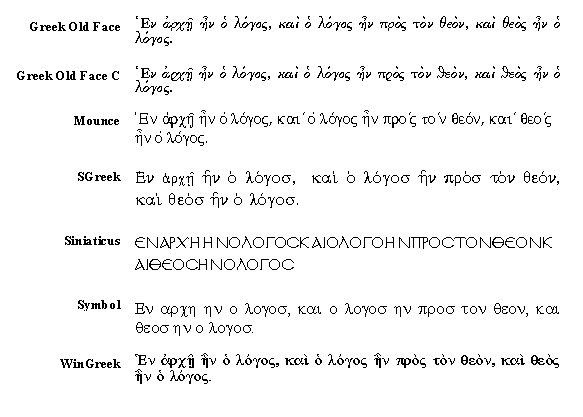
A lot of people have asked me for advice on Greek fonts, so I am trying to keep up-to-date information here on this page. Currently, a real hodge-podge of commercial and shareware fonts are being used for Greek, and odds are pretty good that anybody else you want to share your documents with does not have the same fonts that you use, so if you send a document to someone else, they will have to download and install your font before they can read your document. The world could really use a high-quality, public domain font for Greek. As a matter of fact, there are a couple that are pretty much finished but haven't yet been released - I can't reveal any information on these, but I would love it if these fonts were finished soon. In the meantime, there are some shareware fonts that are pretty good. I would strongly suggest that most people use TrueType fonts, which work in word processors on both Windows and Macintosh systems, and can also be used in web pages. That means that you have a fighting chance of sharing your documents with people who use different computers. And until there are better public domain fonts, I suggest using shareware fonts that are reasonably cheap, so you can distribute your documents to others without forcing them to pay for some of the more expensive font packages.
If you do not need accents or breathing marks, you can always use the Symbol font, which is available for free on both Windows and Macintosh, but for most purposes this is not very satisfactory. If you have a commercial Bible software program, it probably came with a font, but the font encodings for different fonts are not generally compatible with other fonts, so if you cut and paste from your Bible software into a word processing program, someone else without the same Bible software program may not be able to read your document. However, sometimes you can substitute one font for another one that uses the same encoding scheme, e.g. the Mounce font can be used as a substitute for the Galaxie fonts that come with the Gramcord and Bible Companion programs for Windows. Look at the font encodings table and see if you can find a font with encodings similar to the font you are trying to replace.
Here are some samples of Greek fonts that you can download from the web.
Here are some useful links to font archives, descriptions of fonts for use with biblical languages, and descriptions of font technology:
To help you make a visual comparison, we have made a table with samples of each font. The fonts might look a little better if they were installed on your system, but the table gives you the ability to make a quick comparison to decide which fonts might be worth downloading. This table was converted to a bitmap using Paint Shop Pro. When you look at these fonts, ask your self these questions:

Here are the samples:

If you display Greek text with an English font, it may look like a lot of garbage. That's because the ASCII characters used to represent fonts are somewhat random, especially when breathing marks and accents are involved. The fonts that look the best also have the weirdest character encodings. The following table shows the actual ASCII text from the table shown above, displaying the characters with standard English characters:
| Greek Old Face, Greek Old Face C WinGreek ("Greek") |
`En ¢rcÍ Ãn Ð lÒgoj, kaˆ Ð lÒgoj Ãn prÕj tÕn qeÕn, kaˆ qeÕj Ãn Ð lÒgoj. |
| Mounce (Same encoding as Galaxie fonts used with Gramcord) |
jEn ajrch'/ h\n oJ lovgo", kaiV oJ lovgo" h\n proV" toVn qeovn, kaiV qeoV" h\n oJ lovgo". |
| SGreek (almost identical to SPIonic) |
E)n a)rxv= h)=n o( lo/goj, kai\ o( lo/goj h)=n pro\j to\n qeo/n, kai\ qeo\j h)=n o( lo/goj. |
| SPIonic (almost identical to SGreek) |
E)n a)rxh=| h)=n o( lo/goj, kai\ o( lo/goj h)=n pro\j to\n qeo/n, kai\ qeo\j h)=n o( lo/goj. |
| Siniaticus | Enarchhnologoskaiologohnprostonqeonkaiqeoshnologos |
| Symbol | En arch hn o logos, kai o logos hn pros ton qeon, kai qeos hn o logos. |
The WinGreek and Son Of WinGreek fonts use the same encoding scheme, which has a separate ASCII character for each printable symbol, e.g. an alpha with a smooth breathing and an acute accent is one ASCII character, and an alpha with a rough breathing and an acute accent is a different ASCII character. Because keyboards are not set up to type these wierd characters, you need to use the macros provided with the fonts. But these fonts have an advantage: they can display the breathings and accents more precisely because they have been carefully fit to each letter.
SPIonic and SGreek have almost identical encoding, based on the BETA scheme used for the Thesaurus Linguae Graecae . They differ in the character used for the iota subscript. These fonts work reasonably well with most of the downloadable Greek texts for the New Testament and Septuagint, except that SGreek has a different character for the iota subscript, and SPIonic has characters in two different widths, and the text comes out looking funny. SGreek is used in the Silver Mountain Software programs.
Mounce uses the same encoding scheme as the commercial Galaxie fonts used in the Bible Companion and Gramcord programs.
Over time, I will be posting more details on font encoding here, including the complete encoding schemes for several fonts, information on keyboard utilities for entering Greek, etc. For now, I hope this was interesting and helpful. If you have any suggestions, send mail to Jonathan Robie.